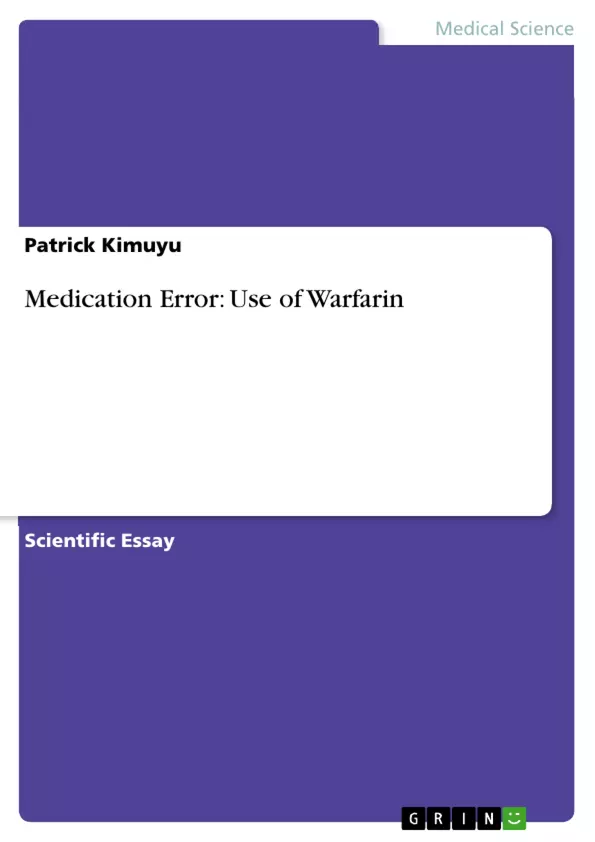Medication errors remain life threatening mistakes affecting the delivery of health care. Medical errors are considered as a global problem capable of increasing the length of hospitals stay, mortality rate and other related costs. Though medication errors can be caused by any healthcare professional, a high percentage of such mistakes are made by nurses especially during drug administration. The current research indicates that thousands of Americans die on an annual basis owing to medication errors. Nurses commit majority of errors during intravenous injection of drugs while poor hand writing witnessed among primary care givers often results to dosing errors. Other primary care givers use abbreviations during prescriptions making it hard for pharmacists to interpret hence rising the risk of medication errors. Medication errors can also be attributed to inadequate pharmacological knowledge and lack of awareness of the route of the administration. Further, Medication errors are also attributed to complexities within the healthcare environment particularly multiple processes involved in the medication process ranging from packaging to the actual administration of the drug (Health Services Support Agency, 2012). This research paper discusses medication error with warfarin and its consequences.
Inhaltsverzeichnis (Table of Contents)
- Introduction
- Warfarin
- Impact of the Error on the Individual and/ or group
- Impact of the Error on the Healthcare System
- Corrective Actions
- Result(s) of Corrective Action
- Conclusion
Zielsetzung und Themenschwerpunkte (Objectives and Key Themes)
This research paper examines medication errors with warfarin and explores their consequences for individuals, healthcare systems, and society as a whole. It delves into the causes and contributing factors of warfarin-related errors, highlighting the significant risks associated with this medication. The paper then explores various corrective actions implemented to mitigate these errors and their effectiveness in improving patient safety.
- Medication Errors: Causes, Consequences, and Solutions
- Warfarin: Properties, Risks, and Management
- Impact of Errors on Individuals and Healthcare Systems
- Corrective Actions: Strategies for Error Reduction
- Patient Safety: Enhancing Patient Care and Outcomes
Zusammenfassung der Kapitel (Chapter Summaries)
- Introduction: This section introduces the pervasive issue of medication errors, their global impact, and their significant contribution to increased healthcare costs and mortality rates. It highlights the specific challenges of medication errors during drug administration, particularly in nursing practice. The introduction emphasizes the prevalence of medication errors involving warfarin and the importance of understanding their consequences.
- Warfarin: This chapter provides an overview of warfarin, a commonly used anticoagulant medication, and its crucial role in preventing blood clots. The chapter discusses the importance of regular laboratory tests to optimize warfarin dosage and the potential risks associated with both high and low international normalized ratio (INR) levels. It also outlines the use of pro-coagulation proteins to manage anticoagulation factors during the initial phase of warfarin medication.
- Impact of the Error on the Individual and/ or group: This chapter focuses on the serious consequences of warfarin medication errors for patients. It highlights the risk of hemorrhage, a potential complication that can be fatal, especially when it affects the brain or spinal cord. The chapter also addresses the dangers of warfarin overdose, which can lead to severe bleeding and necessitate emergency surgery. The text emphasizes the potential interactions between warfarin and other medications, which can decrease its effectiveness and increase the risk of stroke.
- Impact of the Error on the Healthcare System: This chapter examines the broader implications of warfarin medication errors on the healthcare system. It cites research studies that reveal the high incidence of adverse events resulting from medication errors, particularly in primary care settings. The chapter discusses the impact of these errors on patient health, leading to hospitalizations and increased healthcare costs. It also highlights the negative impact on the reputation of healthcare institutions and the erosion of patient trust in their healthcare providers.
- Corrective Actions: This chapter explores various strategies implemented to minimize warfarin medication errors. It emphasizes the importance of effective communication between patients and healthcare providers, including the verification of medications against prescribers' orders. The chapter highlights the role of reporting near-miss incidents to identify potential risks and improve safety measures. It also discusses the availability of support systems for patients who have experienced treatment injuries, providing compensation for lost income and treatment costs.
- Result(s) of Corrective Action: This chapter presents evidence of the effectiveness of corrective actions in reducing warfarin medication errors. It cites a study at Southdale Hospital in Edina, Minnesota, which demonstrates a significant reduction in errors through the implementation of safety strategies. The chapter also highlights the benefits of Computerized Physician Order Entry (CPOE) and bar codes in improving medication safety and minimizing the potential for errors.
Schlüsselwörter (Keywords)
This research paper centers around the critical issues of medication errors, specifically focusing on warfarin-related errors. Key themes include patient safety, drug administration, anticoagulation therapy, INR monitoring, adverse events, corrective actions, and healthcare system improvements. The paper also explores strategies for reducing medication errors, highlighting the importance of effective communication, patient education, standardized procedures, and technological advancements such as CPOE and bar codes.
- Quote paper
- Patrick Kimuyu (Author), 2016, Medication Error: Use of Warfarin, Munich, GRIN Verlag, https://www.grin.com/document/381303



